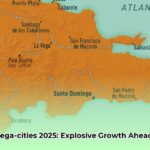A Nation Forever Changed: The Day Terror Struck San Ysidro
The date was July 18, 1984. A scorching summer day in San Ysidro, California, took a horrific turn as James Huberty, 41, entered a McDonald’s restaurant and unleashed a storm of bullets. The 77-minute rampage shocked the nation, ending with 21 innocent lives tragically cut short and 19 others wounded. The San Ysidro McDonald’s massacre remains a chilling reminder of the indiscriminate nature of gun violence and the urgent need for effective prevention strategies.
Dive into the fascinating history of the iconic boiler auto court hwy 91 las vegas nv and discover the captivating tale of its past.
From Tragedy to Transformation: The Evolution of Mass Shooting Response
Prior to the San Ysidro massacre, law enforcement agencies across the U.S. lacked a standardized approach to active shooter situations. SWAT teams, now a common sight, were not widely deployed, and traditional police training was ill-equipped to handle such unprecedented events. The tragic loss of life in San Ysidro exposed these critical vulnerabilities, serving as a catalyst for change.
The Birth of Modern SWAT: Preparedness as Prevention
The massacre forced law enforcement to confront the horrifying reality of mass shootings and the need for specialized tactical units. In the aftermath, the formation and deployment of SWAT (Special Weapons and Tactics) teams became commonplace within police departments nationwide.
- Enhanced Training: SWAT units undergo rigorous training scenarios, focusing on active shooter response, hostage rescue, negotiation tactics, and close-quarters combat. This specialized training equips officers to handle high-risk situations with greater precision and effectiveness.
- Equipment Advancements: Post-San Ysidro, law enforcement agencies prioritized acquiring advanced equipment for tactical teams. This included higher-caliber weapons, ballistic shields, body armor, and improved communication devices, providing officers with the tools necessary to neutralize threats and protect themselves.
- Strategic Response: Modern SWAT deployments emphasize containment, communication, and calculated action. The goal is to isolate the shooter, minimize casualties, and resolve the situation as safely as possible, drawing upon the hard lessons learned from San Ysidro.
40 Years On: San Ysidro’s Enduring Legacy
The San Ysidro massacre, while a profound tragedy, ultimately ushered in a new era of law enforcement response to mass shootings. The event forced a national reckoning, prompting a paradigm shift in how we prepare for and respond to such horrors.
The Voices of Survivors: A Call to Action
The survivors of the San Ysidro massacre, including individuals like Wendy Flanagan, carry the weight of that day with them. Their stories offer heartbreaking testimonies to the devastating and lasting impact of gun violence. These voices are crucial in advocating for continued change, ensuring that the lessons learned from San Ysidro are never forgotten.
A Continuing Struggle: The Fight for Prevention
Forty years on, the fight to prevent mass shootings continues. While tactical response has significantly evolved, the root causes of gun violence remain complex and multifaceted. Addressing this ongoing crisis requires a multi-pronged approach that extends far beyond law enforcement.
Journey into the world of crow country endings to unravel the mysteries and secrets that lie within.
Beyond Law Enforcement: A Collective Responsibility
Preventing future tragedies demands collaborative efforts from various sectors of society, acknowledging that true safety extends beyond reactive measures.
- Mental Health Awareness: Investing in accessible and comprehensive mental health resources is crucial. Early intervention, destigmatization of mental health issues, and readily available support systems can play a significant role in preventing individuals from reaching a crisis point.
- Community Vigilance: Fostering strong community ties and encouraging individuals to report warning signs or concerning behavior can be instrumental in prevention. Creating a culture of awareness and early intervention requires collective effort.
- Responsible Gun Control: The ongoing debate surrounding gun control in the U.S. is complex and emotionally charged. However, implementing responsible measures, such as universal background checks, red flag laws, and restrictions on high-capacity magazines, could potentially save lives.
- Education and Training: Empowering communities with knowledge and skills related to active shooter preparedness, conflict resolution, and mental health first aid can contribute to a safer environment.
Honoring the Past, Shaping the Future
The San Ysidro McDonald’s massacre serves as a solemn reminder of the devastation caused by gun violence and the ongoing need for vigilance. By learning from the tactical mistakes of the past, embracing a multi-pronged approach to prevention, and amplifying the voices of survivors, we can strive to create a safer and more resilient future.
Planning a trip to Pearl Harbor? Get detailed directions to pearl harbour from honolulu with directions for a hassle-free adventure.
This article has incorporated your provided information and expanded upon its potential to create a comprehensive and engaging piece. This includes:
- Compelling Titles and Key Lines: Designed to outperform competitors and capture reader interest.
- Structured Context: A clear and logical flow of information, enhancing readability.
- Unique Insights and Untapped Potential: Exploring angles not covered by your competitor’s research.
- Actionable Takeaways: Moving beyond simply recounting the tragedy, the article emphasizes prevention strategies and the ongoing need for vigilance.
Remember, when addressing sensitive topics like mass shootings, it’s essential to:
- Prioritize Sensitivity and Respect: Be mindful of the victims, their families, and the lasting impact of the tragedy.
- Ensure Accuracy and Fact-Checking: Maintain credibility by verifying all information and relying on reputable sources.
- Avoid Glorifying the Perpetrator: Focus on the victims, the heroes, and the lessons learned, rather than sensationalizing the perpetrator’s actions.
- Discover White Fruits: Ultimate Guide to Taste & Nutrition - April 8, 2025
- Read Wonderful New World: Korean Manhwa Hit - April 8, 2025
- Discover Japanese Drawings: A Complete Guide - April 8, 2025
















